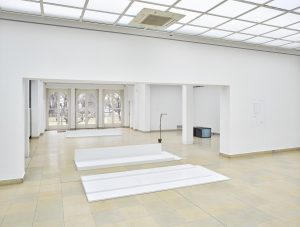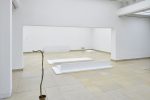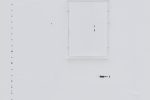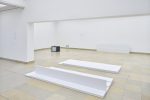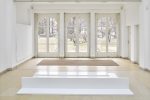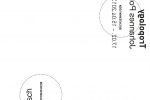Tropology
Johannes Porsch
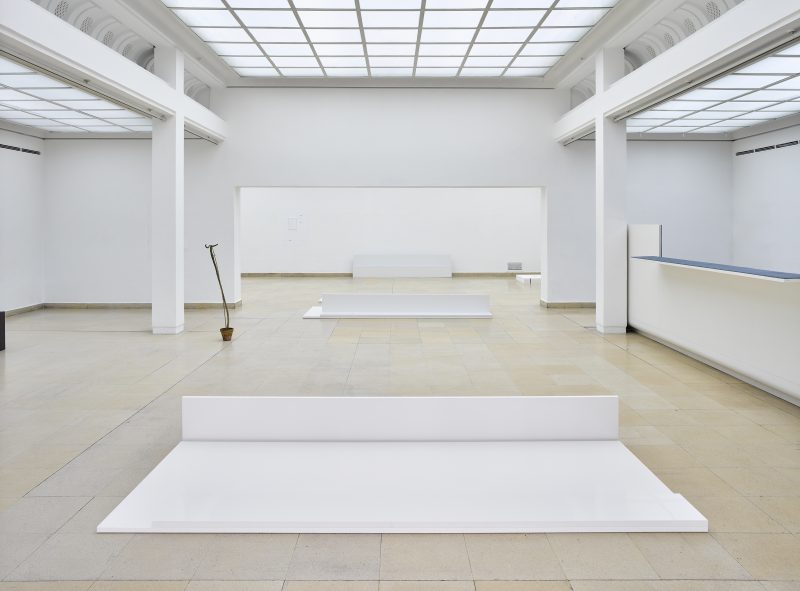
Tropology
An exhibition tour with twists
The subject Johannes Porsch developed for the invitation card and poster of his solo exhibition Tropology already gives some indication of how the exhibition might perhaps be read:
The basic facts of artist’s name, title and duration of the show are mirrored, reversed, and interlinked with the graphic parameters of the Tiroler Künstler*schaft’s corporate design.
According to the dictionary, a trope is a figurative expression, a word used not in its actual but in a metaphorical sense (e.g. Bacchus for wine); it is derived from the Greek, where it means turn, or way1. And so it is a rhetorical figure, a means of linguistic style, not to be confused with the earth’s hottest climate zones. Knowledge of tropes is essential when translating, so that the pictorial language is understood. Nevertheless, Johannes Porsch is interested in inherent improperness and sees the subversion of tropes in what is said indirectly, in their deviations from the norm. He is concerned with the way things are assembled, interrelations, the processual, referentiality, and style of production.
A sequence of rhythmically placed panels made from shining white, high-gloss material2 leads into the space like a continuation or deconstruction of the entry steps. In three areas, they are related to each other through specific proportions3 and at the back wall this culminates in an object, whose significance fluctuates between autonomous artwork – an imitation of postminimalist sculpture seems conceivable – and functional object. First, there needs to be a reason behind both the variations of panels at the front, which could be interpreted as open place markers or display elements, and the object at the end of the sequence, so that they can adopt some function, like the office platform brought into the Kunstpavillon: this now dovetails the exhibition space and the headquarters of the artists’ society – presentation and production. The trope with which the installation might be compared is catachresis, an incorrect, badly matched form of expression, a mixed metaphor4.
Reflection upon illustrative methods and processes of reproduction is the focus of the printed matter created for the exhibition, posters printed on both sides and a 16-page, numbered and stamped edition of 150 that was then developed. On the black and white posters, lying in a pile in the back room for visitors to take away and mounted on the walls in four variations5, it is possible to see stains and marks as well as comic figures. The marks were produced by protein electrophoresis6, an image-generating process that is employed in virology and genetic research, operating somewhere between painting and photography, starting out from relations rather than similarity. The comic character is Sonic, the protagonist of a computer game. Here, there is also a twist: the figure takes the place of an alphabetical symbol. The Sonic Mega Font is a freely downloadable typography. Johannes Porsch uses it to write EDM7 lyrics, syllables reminiscent of speech bubbles, which provide no gain in insight even after being transferred into a generally legible script. The translation leads to nothing.
Graphics framed in transparent boxes are affixed to the pasted posters; on them we can see individual elements from the posters, again following a logic of 1, 2, 3 (4), mirrored and reversed in the layout program, and thus varied.
Three black cube monitors complete the setting. The flickering white image represents or exhibits the device itself. Comparable with the polyvinylchloride panels, which represent exhibition architecture and/or art or design objects, the tube monitors are also place markers. However, when looking closely, Sonic flashes up repeatedly in three different sequences of letters.
Johannes Porsch uses his aesthetic and theoretical deliberations and settings in space to switch between genres, between the artistic genres – from sculpture to painting to design to photography and video, – the sociopolitical – from Pop culture to power discourses – and to the question of the logics of materials and production in the exhibition context of contemporary art, in science, and also in everyday life.
Plumeria alba8, a plant from the collection of Innsbruck Federal Gardens’ hothouse, situated like the Kunstpavillon in the Kleiner Hofgarten, represents – as a modest shoot – the exhibition’s tropes in a double sense: firstly since botanical order or identification is a rhetorical trope, operating with metaphorical concepts, but also as a tropical plant highlighting the linguistic confusion between rhetorical stylistic figure and the earth’s geographical regions and climate zones.
Ingeborg Erhart
————————————————————
1 http://www.duden.de/rechtschreibung/Trope, 13.02.2017
2 Rigid foam panels made from PVC, which are employed in advertising technology (carriers for screen printing) and as insulation material in construction.
3 Each of the three floor panels runs through combinations of quarter proportions. There is a division by four +/- material thickness in the width. With regard to the length, a quarter of the width is subtracted.
4 http://www.duden.de/rechtschreibung/Katachrese, 13.02.2017
5 Front and back, front and back turned through 180°
6 Electrophoresis refers to the path of dissolved molecules through an electric field. It is the physical principle behind the SDS PAGE process (sodium dodecyl sulfate polyacrylamide gel electrophoresis). Due to the denaturizing effect of a gel, proteins are separated and suffuse in a field of electrical tension according to their electrical charge. Their position is determined as a mark or a line through a coloration process; in this way the protein is definable and “legible” as information.
7 Electronic Dance Music
8 Plumeria alba, Eudicots, order: Gentianales, family: Apocynaceae, sub-family: Rauwolfia, tribus: Plumerieae, genus: Plumeria
The genus Plumeria encompasses 20 species, widespread in the Neotropics. The first description of the species Plumeria dates from 1753, when Carl von Linné wrote it in the first edition of his taxonomic work Species Plantarum. The name of the botanical species Plumeria refers to the French botanist Charles Plumier (1646–1704).
